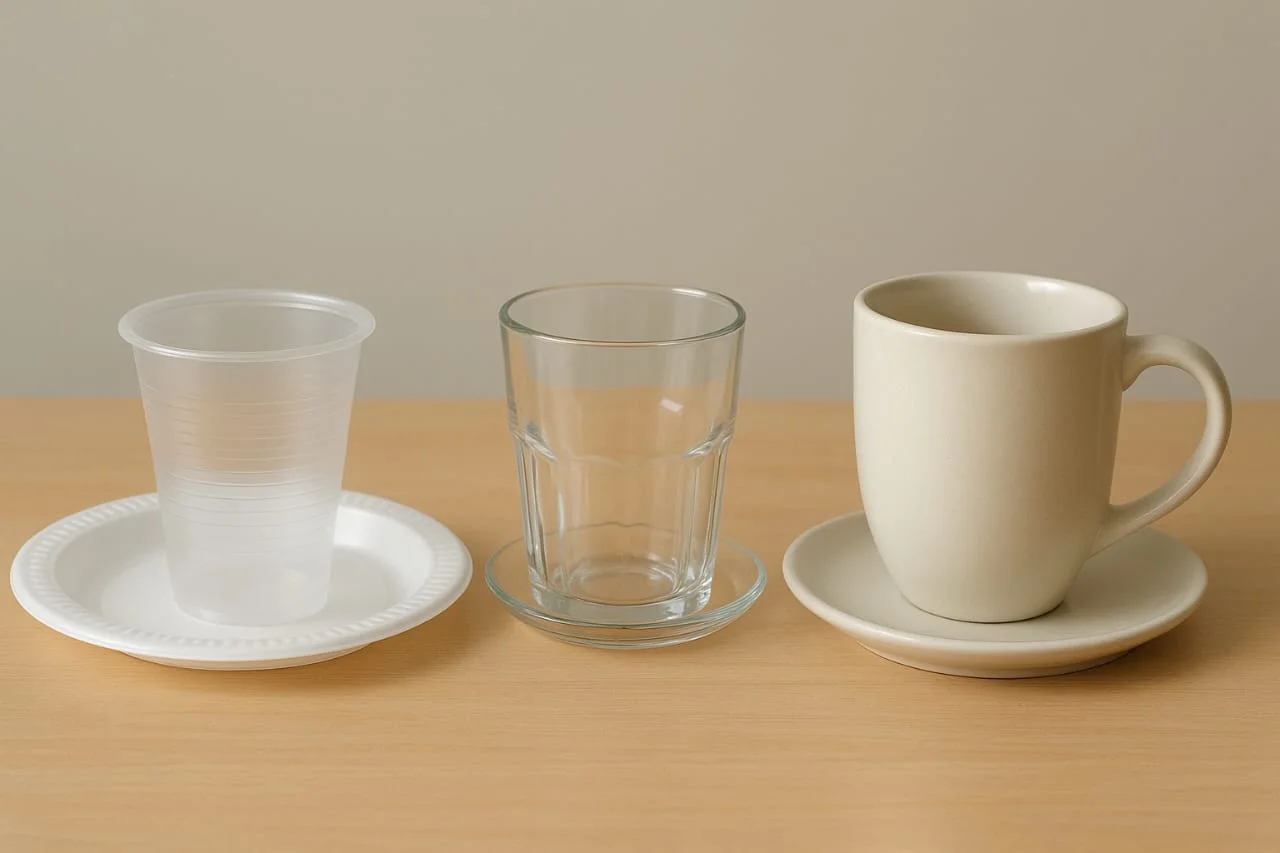By News Karnataka Editorial Team
Copyright newskarnataka

Eating and drinking are daily activities that everyone takes for granted, but the materials we use for them are not always given much thought. Whether it is a plastic cup, a ceramic plate, or a glass bottle, these objects are part of almost every meal. These items are so common that they often go unnoticed, blending naturally into our routines. A water bottle, a teacup, or a dinner plate may seem like simple choices, yet they represent different materials that we handle constantly. Most of the time, we select them based on what is near us, what looks appealing, or what feels convenient at the moment. Rarely do we pause to ask if one material is safer than another, or if all of them carry the same level of trust. Plastic may seem practical, ceramic may feel traditional, and glass may look elegant, but our decisions are often made without deeper reflection. This habit of unexamined use makes us wonder if we really know enough about what we are relying on every day. It raises questions not only about comfort and preference but also about awareness. By thinking more carefully about these materials, we may begin to see that even ordinary choices in eating and drinking have more meaning than we realize.
Respondents’ Views on Using Glass, Ceramic, and Plastic in Daily Life
Jennieswari Mayengbam asked which material she usually uses while drinking and eating she responded “After noticing the smell left in plastic materials, I researched online and became aware of the health impacts of using plastics, as they can release unwanted chemicals that are harmful to the human body. Since then, I prefer using glass, especially when consuming hot drinks.” She also advises her friends and family to reduce their use of plastics in daily life. By making this change, she feels more confident about protecting her health and the environment.
Aamir explains that he usually eats at home, where they use glass and ceramic materials. If it happens to eat food from outside, he makes sure to use paper containers rather than plastic. “Ceramics and glass are fine in my opinion, as they are not harmful to nature like plastics. Since they can be collected and recycled without causing harm, they serve as better alternatives to plastic.” he added. He further says that plastic not only causes harm through eating or drinking, but also through being thrown away in unsafe places and burned, which destroys human beings.
Nguyen Thi Thanh Nhan, asked if she is aware of the health impacts of using plastic and responded: “Definitely. Misusing plastic is not a good habit, as it can harm both the environment and human health. One of the major concerns is the rising presence of microplastics, which can enter the body through food and water. Over time, these tiny particles may accumulate in the blood and organs, posing serious health risks.”
What Science Says About Eating and Drinking from Glass, Ceramic, and Plastic
Mr. Amos C. L. a Research Scholar on Polymer Chemistry Research Laboratory, Department of Chemistry at Mangalore University explains why using Plastic material while eating or drinking considered unsafe.
“It is considered unsafe to drink water or eat food stored in plastic containers because plastics can release harmful chemicals into the water or food, especially when exposed to certain conditions. Many plastics contain chemicals such as bisphenol A (BPA), phthalates or styrene, which are added to make plastic materials durable or flexible. In particular, when plastic is heated, scratched or reused over time, these chemicals can leach out and contaminate the food or water. In addition, at certain circumstances, such as when food or drinks are hot, plastic bottles left in the sun or use of low-quality plastics there is a chance of release of microplastics (tiny plastic particles) that can contaminate with food and drinks. Accumulation of these microplastics in the body may cause inflammation or other unknown long-term health effects.”
When he asked if it is unsafe for cold, warm, and hot water and food alike, he responded: “the safety of using plastic materials depends on several factors particularly the temperature of the water or food. For the cold water or food can be regarded as safe because plastics leach fewer harmful chemicals at low temperatures. However, prolong storage or exposure to sunlight can release chemicals or microplastics into cold water or food. For the warm water or food, the risk increases, as the plastic can be softened and speeds up the leach of harmful chemicals. For the hot water or food is the most unsafe because high temperature causes plastics to break down and release harmful chemicals at much higher levels.” He added that though plastic materials are designed for convenience, durability and cost-effectiveness in packaging, construction, healthcare, electronics, transport and textiles, their problem is not their design itself, but their misuse (like with hot water or food) and persistence in the environment.
Plastics have become part of our everyday lives, yet research shows they can harm human health in many ways. One major concern is Bisphenol A (BPA), a chemical commonly found in plastic bottles, food containers, and even cans. BPA acts like the hormone estrogen in the body, which disrupts hormonal balance. Studies by the Endocrine Society link BPA exposure to infertility, early puberty, and higher risks of breast and prostate cancer. Another group of harmful chemicals is phthalates, which are used to make plastics soft and flexible. They are present in items such as shower curtains, vinyl flooring, and food wraps. According to the CDC, high phthalate exposure can lower testosterone levels and may also contribute to asthma and allergies in children. In addition, microplastics have become a growing concern because they are now detected in bottled water, seafood, and even table salt. A University of Newcastle study estimated that humans may consume around 5 grams of plastic each week roughly the weight of a credit card. These tiny particles can cause inflammation and may build up in vital organs over time. The way we use plastics also matters, since heating food in plastic containers can release dangerous chemicals into meals. The Food Safety and Standards Authority of India advise against microwaving or storing hot food in plastic. Safer alternatives such as glass, ceramic, or stainless-steel containers are strongly recommended. Taking small steps to avoid plastic contact can reduce these risks and protect long-term health. (source: Health Risks Of Common Household Plastics: Impact Of Plastic Toxicity On Health)
Plastic Use Endures Even in the Face of Research on Its Harms
Even though research has been conducted and information about the effects of plastic materials is widely available, many people still continue to prefer using them. This shows that awareness alone is not always enough to change habits. Plastic remains popular because it is cheap, light, and easy to access, which makes people overlook possible concerns. At the same time, business houses such as restaurants and food outlets rarely stop serving customers with plastic materials. For them, plastic is convenient, cost-effective, and suitable for quick service. Even when alternatives like paper or biodegradable products exist, these are often ignored because plastic seems more practical. Customers, too, may accept plastic without questioning it, since it is so common. The cycle of use continues despite the information that warns against it. This creates a gap between knowledge and practice. It also raises the question of whether stronger measures are needed to reduce plastic use. Until then, both individuals and businesses may keep choosing plastic as their first option.



